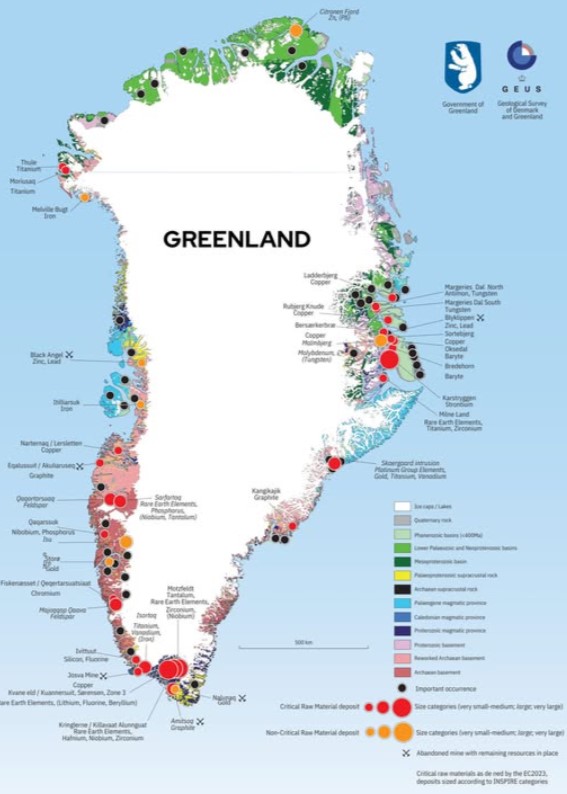Greenland: A Geological Treasure Trove in a Changing World
Greenland, the world’s largest island, is more than just a vast, ice-covered expanse—it is a geological goldmine. Beneath its frozen surface lies some of the oldest rock formations on Earth, remnants of the planet’s original crust that have endured for billions of years. Within these ancient stones, a wealth of valuable resources remains locked away: rare earth elements, gold, platinum, iron, uranium, and even diamonds.
![]()
A Land of Untapped Wealth
As Greenland’s ice sheet continues to recede due to climate change, new areas of land are becoming accessible, sparking increased interest in its mineral resources. Mining companies and governments alike are eyeing the island for its potential to supply critical materials needed for modern technology and the global green energy transition.
Key among these are rare earth elements, such as neodymium, which is essential for the production of wind turbines and electric vehicle motors. Many of these minerals are found in Greenland’s unique geological formations, including carbonatites, pegmatites, and banded iron formations, particularly in southern Greenland and the Gardar Province.
![]()
The Global Race for Resources
Greenland’s mineral wealth places it at the center of a complex geopolitical and economic struggle. As the world races to secure critical resources for the future, the island finds itself at a crossroads where ancient geology meets modern politics and environmental challenges.
The crucial question remains: Who will have the final say in Greenland’s future? Will its vast resources be developed for global benefit, or will environmental concerns and political interests limit extraction?
For a closer look at Greenland’s geology and mining potential, visit: www.greenmin.gl
🔗 Explore more space and science content: www.fromquarkstoquasars.com
The United States has long been interested in Greenland for several key strategic, economic, and geopolitical reasons:
1. Strategic Military Importance
Arctic Defense & Security: Greenland’s location between North America and Europe makes it a critical asset for Arctic defense. The U.S. has a military presence at Thule Air Base, the northernmost American military installation, which plays a crucial role in missile defense, space surveillance, and early warning systems.
Russia & China’s Arctic Ambitions: As Arctic ice melts, new shipping routes and resource opportunities emerge, making the region a focal point of great-power competition. The U.S. wants to ensure that Russia and China do not dominate Arctic affairs, especially given Russia’s military expansion in the region and China’s growing economic ties with Greenland.
2. Rich Natural Resources
Greenland holds vast reserves of rare earth elements (REEs), gold, uranium, iron, and diamonds. These minerals are crucial for modern technologies, including smartphones, electric vehicles, and renewable energy systems.
The U.S. is highly dependent on China for rare earth elements, which are vital for military and tech industries. Securing access to Greenland’s resources would reduce reliance on China and strengthen American supply chains.
3. Geopolitical Leverage in the Arctic
As the Arctic opens up due to climate change, new shipping routes such as the Northern Sea Route are becoming more viable. Controlling Greenland gives the U.S. greater influence over Arctic trade and navigation.
The U.S. has been wary of China’s growing influence in Greenland, particularly through investments in mining projects and infrastructure. Denmark, which controls Greenland’s foreign policy, has blocked Chinese investments due to U.S. pressure.
4. Historical Interest in Acquiring Greenland
The U.S. has previously tried to buy Greenland. In 1946, President Harry Truman offered Denmark $100 million for the island, but Denmark refused.
In 2019, President Donald Trump expressed interest in purchasing Greenland again, citing its strategic and economic value. Denmark rejected the idea, but the incident highlighted the U.S.’s long-standing interest in the territory.
Conclusion: A Key Player in the Arctic
Greenland sits at the intersection of global security, resource competition, and climate change. As Arctic ice melts and geopolitical rivalries intensify, the U.S. will continue to focus on Greenland as a key piece in its Arctic strategy—whether through military cooperation, investment in mining, or diplomatic influence.
Would you like insights on specific U.S. policies regarding Greenland?

